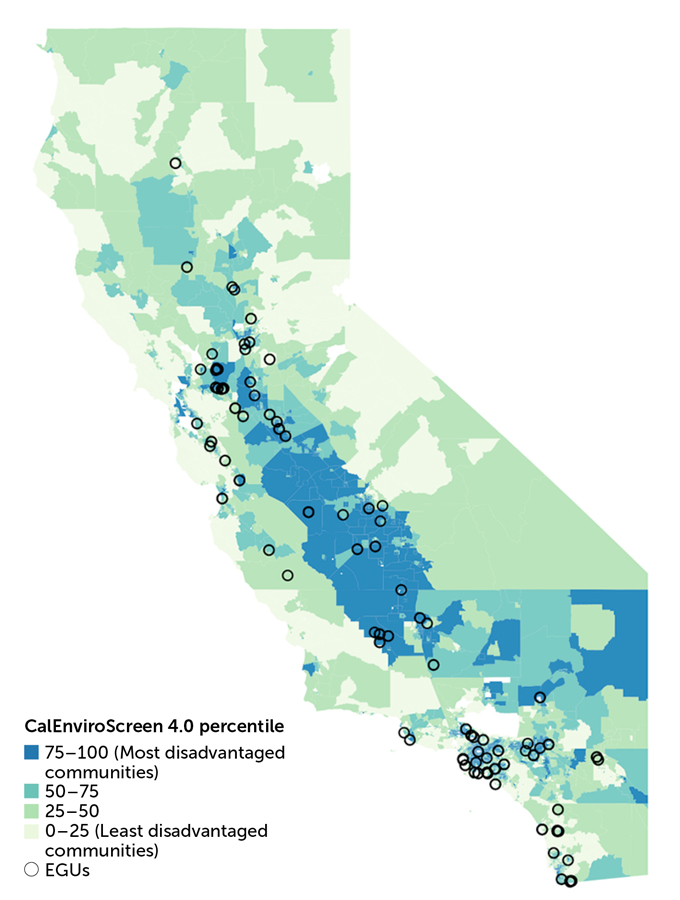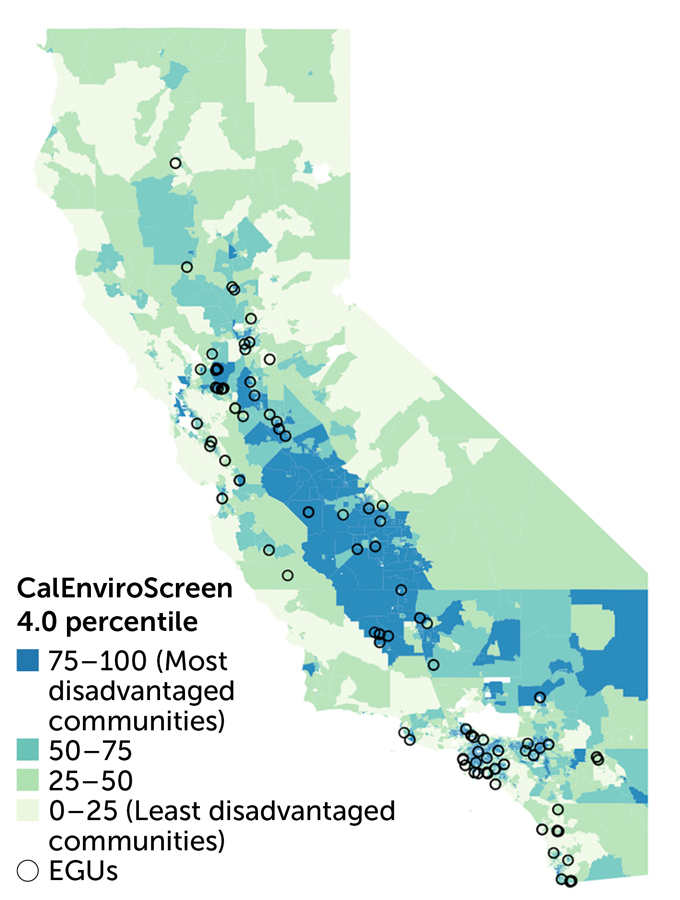A worldwide gearshift from fossil fuel–powered cars to electric vehicles could significantly reduce the amount of carbon dioxide that humans emit to the atmosphere. But current strategies for vehicle electrification can also shift some pollution to communities already suffering under higher economic, health and environmental burdens, researchers warn.
California, which leads the United States by a mile when it comes to EV adoption, offers a window into this evolving problem. The state is aggressively seeking to reduce its carbon footprint and has made substantial increases in wind and solar power generation as well as in the promotion of electric vehicle purchases. One tool the state has used is the California Clean Vehicle Rebate Project, or CVRP, which kicked off in 2010 and offers consumers money back for the purchase or lease of new EVs.
Now, an analysis of the CVRP’s impact on the state’s air quality from 2010 to 2021 reveals both good and bad news, researchers report May 3 in PLOS Climate.
To assess the impact of the CVRP on a community and statewide level, the team developed a computer model that incorporates data on where the rebates went, how much additional electricity would be required to power those vehicles, which of the state’s electric generating units would provide that power and how much pollution they might produce.
The team then overlapped these data with a mapping tool called CalEnviroScreen that identifies which of the state’s more than 8,000 census tracts — county subdivisions used in population assessments — are the most vulnerable to pollution. That vulnerability measure is based not only on exposure to pollutants such as power plant emissions and unsafe water but also on factors such as income, education level, access to health care and linguistic isolation.
The good news is that the CVRP is responsible for making a dent in the state’s overall CO2 emissions, reducing them by about 280,000 metric tons per year on average, says environmental scientist Jaye Mejía-Duwan of the University of California, Berkeley. In 2020, transportation in California produced about 160 million tons of CO2, about 40 percent of the total 370 million tons of CO2 emitted by the state that year.
The program has also reduced the state’s overall emissions of other types of air-polluting gases, including sulfur dioxide and several nitrogen oxide gases collectively called NOx.
The bad news is that the most disadvantaged communities in the state didn’t see the same overall improvement in air quality, Mejía-Duwan and colleagues found. Those communities didn’t have the same decreases in sulfur dioxide and NOx gases — and in fact saw an increase in one type of air pollution, tiny particulates known as PM2.5 (SN: 7/30/20). “These particles are small enough to penetrate deep into the lungs and cross over into the bloodstream,” increasing the risk of cancer, cardiovascular problems and cognitive decline, Mejía-Duwan says.
That increase may be indirectly related to putting more EVs on the road. Although electric vehicles themselves don’t produce PM2.5 from their tailpipes, increased electricity generation, if it’s not fossil fuel–free, can. Renewable resources, including rooftop solar cells, supplied about half of California’s electricity in 2022. But natural gas–fired power plants still provide a hefty chunk of the state’s power.
“Electric vehicles are often incorrectly referred to as ‘zero-emission vehicles,’ but they’re only as clean as the underlying electric grid from which the energy is sourced,” Mejía-Duwan says. The most disadvantaged 25 percent of the state’s communities also contain 50 percent of the power plants, the team found.
EVs also tend to be relatively heavy due to their hefty batteries. And “heavier vehicles can produce as much if not more particulate matter” than equivalently sized fossil fuel-powered cars, due to brake, tire or road wear, Mejía-Duwan says.
Increasing the cleanliness of the electric grid would help, as would changes to the management of the state’s generated power, the researchers say. California’s solar, wind and hydroelectric energy production has grown rapidly. But the battery technology to store and use that energy later lags behind. Most of that energy is generated during the day, so some researchers have suggested plugging in electric vehicles while it’s light out to take advantage of the daytime glut of electricity — and then using the vehicles to help power houses at nighttime (SN: 12/22/21).
But, clever as that idea is, it doesn’t address the underlying factors behind these inequities. Since 2010, the CVRP has provided over 400,000 rebates for EVs of up to $7,500, depending on income. Yet, as it turns out, those rebates have disproportionately gone to the least disadvantaged communities. “That’s a major driver of these inequities,” Mejía-Duwan says.
Changing that isn’t an easy fix. The state has tried several ways to address the issue, such as by imposing an income cap on eligibility.
But those efforts have had little effect, particularly given strong barriers that stand in the way of the adoption of EVs by people in disadvantaged communities. One roadblock is that prospective EV buyers must have enough money for a down payment, and then fill out forms and be able to wait several months for the rebate money. Another is that car manufacturers are trending toward producing larger, more expensive EVs. Chevrolet, for example, announced in April that its most affordable EV, the Bolt, will be discontinued as the company pivots to producing electric SUVs.
There’s also a lack of equitable access to vehicle charging infrastructure. And then there are subtler but no less insidious issues, such as “a lack of sufficient multicultural and multilingual outreach about EVs, plus the fact that people of color and minoritized communities report facing discrimination at dealerships,” Mejía-Duwan says.
These findings echo and support researchers’ longtime concerns about how current programs to encourage vehicle electrification will disproportionately impact people. “It’s not a surprise,” says Román Partida-López, senior legal counsel for transportation equity at The Greenlining Institute, a nonprofit organization based in Oakland, Calif. “What [California] is doing is a move in the right direction, but it’s not enough.”
California and other states pursuing aggressive zero-emissions policies need to shift their thinking, Partida-López says, to be more intentional about targeting their efforts toward the communities experiencing the greatest impacts (SN: 12/14/22). Rebates, in particular, are known to be an inequitable approach, he says, because they “assume you have the money up front to be able to put down a down payment of several thousand dollars.”
A better strategy to reduce the barriers to EV adoption, he says, would be to provide other types of incentives, such as vouchers that low-income households could use at the time of purchase as well as accessible financing programs.
After all, making EVs accessible to everyone is going to be essential to the big picture of transitioning to zero emissions (SN: 1/27/23). “We’re not going to meet any of those goals unless we center equity” in program designs, Partida-López says. “The focus has always been, ‘How do we transform the market?’ We need to change the narrative to ‘How are we going to focus on the people most impacted, to help with this transition?’”
"electric" - Google News
May 12, 2023 at 11:00PM
https://ift.tt/DEcNLOr
There's good and bad news with California's electric vehicle program - Science News Magazine
"electric" - Google News
https://ift.tt/1zI27Dy
https://ift.tt/An87cqD


No comments:
Post a Comment